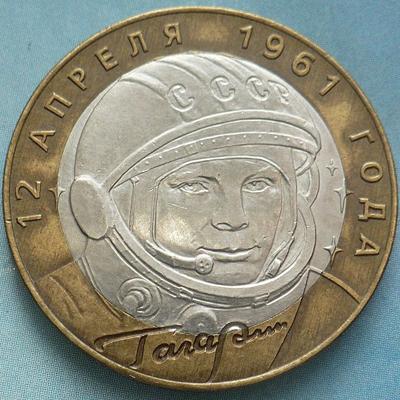Soviet space memorabilia
Russian rouble (Photo: Russian Federation)
By Alex Gallafent
Two major events in the history of space exploration are about to celebrate their anniversaries. Yuri Gagarin became the first human in space 50 years ago tomorrow. Less than a month later, astronaut Alan Shepard became the first American in space. And if you’re in New York in time any soon, you too could own a piece of the Space Race.
If it’s a spaceship you’re after the place to go is Sotheby’s auction house.
It’s selling an actual Soviet spaceship – the Vostok 3KA-2 – with a guide price of between $2 and $10 million.
David Redden, the vice chairman of Sotheby’s, said that this isn’t the Vostok capsule that Gagarin flew in. This is one used in a final, unmanned test flight.
“It was the dry run, so it went up two and half weeks before Gagarin’s extraordinary flight, and carried with it a mannequin and a live dog. The dog and the mannequin came back safe and that gave the green light to Gagarin.”
Across town in New York, a different auction house, Bonham’s, is about to hold its own space sale.
It’s got a handful of Gagarin-related items, but the real focus is on the American space program, with objects including a neck tag worn by Ham, the first so-called astrochimp sent to space by NASA.
Robert Pearlman, founder of CollectSpace.com, a website for space history enthusiasts, said unlike the Americans, the Soviets were secretive about their space missions.
Stowing souvenirs
“At the very start of the Soviet program, were you caught taking any souvenir of the program, that’d probably have you sent to Siberia. In the US program it was actually encouraged for the engineers working on the program to snip off pieces of returning spacecraft and to stow souvenirs aboard the spacecraft – so long as it didn’t interfere with the operation of the mission.”
Engineers stowed things like dollar bills, rolling them up and placing them behind instrument panels. But over the past 50 years the attitudes were reversed.
The United States became much more careful about what it allowed into space. In contrast, the Soviets began to relax their rules, right up until the collapse of the Soviet Union, when the rules went out the door, along with countless collectibles.
James Oberg, a space historian and former NASA rocket scientist, said the sale of that Soviet material was in some cases necessary.
“These were often things you’d say the families should want to keep, but in those days in the 90’s they’d rather eat,” Oberg said. “They made some good money and it brought a lot of people through some tough times.”
These items were at least preserved, although the lack of a solid paper trail made it hard for people to prove their authenticity.
Today, said Robert Pearlman, the Russians have fully embraced the commercialization of space, including flying so-called space tourists into orbit.
“They have allowed commercial payloads to be flown on their spacecraft,” said Pearlman. “And they’ve allowed their cosmonauts to be more active in selling memorabilia that flew onboard with them.”
Shuttle program
That means there’s now more Soviet memorabilia on the market than American, at least in terms of newly available items. But there are still other fertile areas for space collectors. For one thing there’s the space shuttle program. With the shuttle coming to the end of its life, it now offers a defined set: 135 missions.
And then there’s all the stuff that was left behind on the moon. You can’t buy anything that’s still up there from NASA’s Apollo missions: the Smithsonian has the rights to all that.
But one businessman has bought a Soviet lunar rover that’s still on the surface of the moon. He also floated the idea that with his purchase he could lay claim to the land underneath the rover, arguing that he was using it as … a parking spot.
We want to hear your feedback so we can keep improving our website, theworld.org. Please fill out this quick survey and let us know your thoughts (your answers will be anonymous). Thanks for your time!
